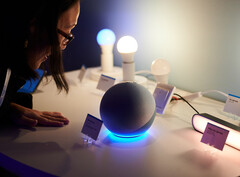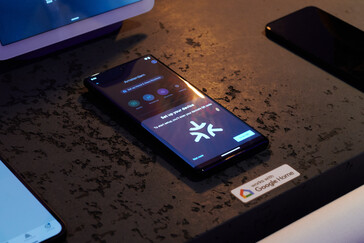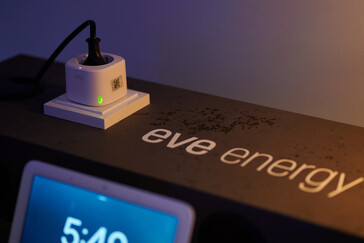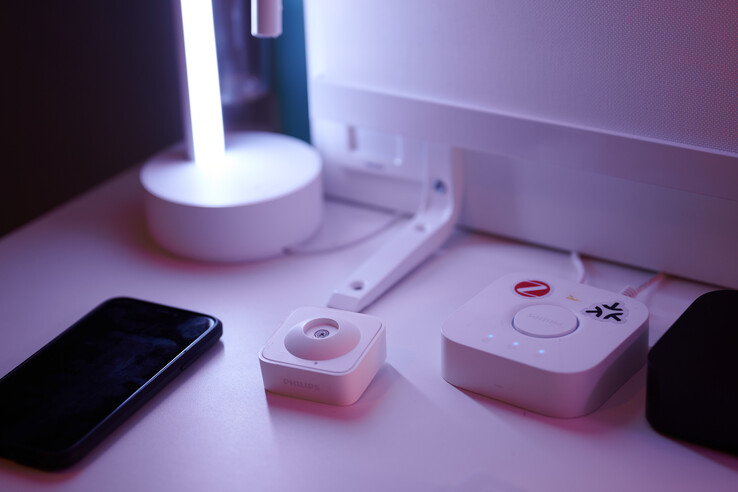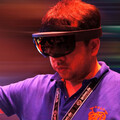The first updates around Matter are expected in December and the following months. These are mainly firmware updates for existing devices, while the ecosystems are already Matter-enabled, at least in part. This includes the Apple system and Samsung's SmartThings. At the recent launch event of the Connectivity Standards Alliance (CSA) in Amsterdam, where Matter was officially launched from the end customer's point of view, and we already reported many details, Notebookcheck.com was already able to talk to some providers.
In advance: The migration will be confusing, but not necessarily complicated. On the other hand, if you're new to Matter, you'll hardly have to deal with details - just as the standard requires.
But let's start with the basics first. Matter, as a language between devices, can be conducted via various radio protocols. This is then called Matter over [technology name]. Matter over WLAN is called Matter over Wifi. This is already an important radio standard that is supported. It also has the advantage that it is widespread and established. Hardly any halfway modern household is still without WLAN these days.
The disadvantage of WLAN technology is usually the power consumption. Sensors are rarely connected via WLAN. Because of the relationship, there is also the classic cable network: Matter over Ethernet. Also not necessarily a technology for small, distant devices. A small door contact sensor with an RJ45 network jack is likely to be very impractical - if it exists at all.
And that brings us to probably the most important wireless protocol: Matter over Thread. A standard that masters mesh, requires little energy, but is unfortunately only found in very new devices. In principle, Matter also supports Bluetooth Low Energy, also known as Bluetooth Smart. However, this is only for setting up the devices. After that, the wireless unit remains silent.
Eve Home upgrades break away from redundancy
That's the case, for example, with Eve Smart Home devices that have been used in the Apple-HomeKit universe until now. Starting December 12, the first firmware upgrades will be available. As Lars Felber, head of PR for Eve Home, told Notebookcheck.com, the upgrade itself will not cause any problems. Eve is ensuring that all features will be retained throughout the migration from HomeKit to Matter. The first devices to receive Matter certification are Eve Energy, Eve Door & Window and Eve Motion, which will then speak Matter with the firmware upgrade.
However, the devices will then only be able to speak Matter. HomeKit will no longer work after that. Downgrading back is also no longer possible. This is an interesting hurdle for the second-hand market, because you can't tell from the outside which firmware has been installed on the devices.
With the upgrade to Matter, Bluetooth is also restricted. The Eve Home devices only need the standard to set up the devices. After that, the wireless standard remains silent. This also means that direct contact with smartphones or the iPad is no longer possible. However, Apple is no longer moving in this direction in terms of development anyway. The hubs in the HomeKit world are the Apple TV and the HomePod Mini. There should no longer be any range problems with Thread anyway. That's why Eve's Bluetooth repeater has also become obsolete with the manufacturer's new devices.
Important for HomeKit users to know: Just because individual devices are switched to Matter, it does not mean that the old devices now no longer work. They remain part of the Smart Home. They just lack the communication path via Matter. The same is true for Amazon and Google. So there is no reason to fear that part of the smart home will suddenly fail in the course of the migration.
It will also be interesting in stores. Devices with old firmware will still be sold there for a while. According to Felber, the packaging of devices with Matter firmware will have a corresponding logo. Of course, they can then be used immediately outside the Apple world. However, older stocks in the stores need an update first.
Hue keeps some redundancy
The situation is somewhat different with the hardware around Philips Hue system (Signify). As Signify said, the new firmware for the Hue bridges is initially only available for developers in beta testing. Then, starting in Q1 2023, the final version will be rolled out. This is a typical legacy device scenario. Philips/Signify says it is bringing all generations of the Hue system into the Matter universe. The Hue bridge does what it's supposed to do. As a Matter-over-Ethernet device, it communicates with the Zigbee lights, making them available throughout the network.
However, there are differences depending on the ecosystem. Philips gives a choice in the Apple universe: users can migrate from HomeKit to Matter, but they don't have to. The background is that HomeKit has individual functions such as Adaptive Lighting that are still missing in Matter. So the bridges will continue to communicate via HomeKit if that's what's desired. Matter is only preset for new installations, according to a Signify spokesperson.
In the Google and Amazon Alexa universe, things are somewhat different. Here, control via the cloud is maintained, but only used as a redundancy level. In other words, if the communication via Matter does not work, then the route via the cloud is used, as Signify promises. In principle, Matter is a local smarthome protocol that does not provide for cloud connectivity.
Google and Alexa suddenly work without the Internet
So the need for a cloud is lost by Google and Amazon's Alexa. Since Amazon was also present at the CSA launch event in Amsterdam, the logistics company was able to clear things up a bit here. From the Alexas' point of view, redundancy is deliberately maintained. Amazon explained that after the firmware update, Echo devices will talk Matter over Wifi or over the cloud, depending on which communication path is easier at the time.
In a detailed blog post for developers, Amazon promises to update 17 Echo devices this year. Very old hardware won't be among them, however, Amazon said. Interestingly, the exact list is not found in the Matter documentation. On site, Amazon only said that the very first Echo Dot will not be supported. The Verge has a more accurate list. The oldest Echo Dot that is supported belongs to the third generation, which appeared in 2018.
This should also be of help as a rough guide for future devices. In the first quarter, the list should then grow to 30 and also include Eero mesh systems.
However, there is one downer for now. The updates coming in December will initially only be usable for the Android community, iOS support will not come until early 2023. The same applies to Matter over Thread.
SmartThings without bridge function
Samsung takes a completely different path with SmartThings. The company made it very clear that they do not offer a bridge function, unlike other companies. The SmartThings hub can use Matter, but not for Z-Wave or Zigbee devices. That will still rely on Samsung's app infrastructure. According to Samsung, you have to continue using the SmartThings app or the already existing opening via Google and Amazon as a cloud service.
So, to complicate things a bit, devices that are connected via the SmartThings hub might only be partially openly addressable via Matter. This is true for smarthome devices connected via Thread, for example. But not for Z-Wave or Zigbee devices.
In the context of the CSA event, this may be surprising, since the alliance propagates open communication and the continued use of all legacy devices. However, Samsung's interpretation obviously does not contradict what the alliance allows, otherwise SmartThings would hardly have been on site in Amsterdam. Compared to the competition, however, this is surprisingly restrictive.
What does this mean that some devices on a single hub might be addressable via Matter and others might not? That remains to be seen in a practical scenario when the first Matter-over-Thread devices are ready, that is, apart from the beta versions. It can also be expected that other companies will have similar restrictions with different protocols. That also remains to be seen, since the documentation, even with Matter support already active, is still insufficient in some cases.
SmartThings at least already demonstrated functionality. The activation of an Eve Energy socket from the SmartThings hub was demonstrated. This would not be possible at all without Matter and thus expands the number of products that Smartthings users can use. SmartThings also assured that communication between Thread devices works without the SmartThings hub, even if the setup went through it.
And the legacy devices?
The question still remains, what happens to all the legacy Smarthome devices that don't handle Matter over Ethernet, Matter over Wifi, or Matter over Thread. As previously indicated, these are devices that talk via Zigbee or Z-Wave, for example. An ideal example in terms of the CSA for this is Schneider Electric. With the Matter-certified Wiser Gateway as a bridge, the entire legacy installation is opened up to the Matter universe.
So those who are already well equipped here only need to buy a bridge and can continue to use their system and start their mishmash with other devices from other manufacturers. This goes so far that, for example, Schneider Electric becomes interoperable with the DECT-ULE standard via AVM using two bridges. AVM already committed itself to Matter at the past IFA and is expected to start the laboratory phase for the first Fritzboxes at the beginning of 2023.
As a result, Zigbee devices will coordinate with DECT-ULE devices in the local network via multiple translators. Until now, this was hardly imaginable. but it will become reality in 2023.
Conclusion: Things don't really get going until 2023
This brings us to the preliminary conclusion, because these are still dry runs and testing could be done with beta hardware at best. But the direction is right, because most of the companies present in Amsterdam were very clear about this new openness. Of course, the scenarios presented here cannot cover every case. Only a fraction of the 300 or so CSA members were present, and even fewer had a booth with demonstrations.
Nevertheless, Matter is likely to please new customers in particular next year. They can look specifically for Matter hardware and bring into their homes a hodgepodge of different companies that formerly did not communicate with each other in the smarthome. If the CSA and its members deliver on the promises, it won't be a hassle. No comparison to what smarthome users are currently used to, especially when seeking and installing solutions across manufacturer boundaries.
However, the path for this new world will probably actually be paved by the early adopters of smarthomes. That's because this clientele has the hardware to experiment around first. The old hardware, which fortunately will not become obsolete with Matter, will be connected to new other devices and the software solutions will be tried out with which the facilities will be carried out. Especially in this area there were still inconsistencies here and there in the conversation with several companies.
In the case of hardware, however, a firmware upgrade is enough here and there, and in other cases at least the purchase of a bridge or a more modern control panel is necessary. But that's all that can really be done to integrate hardware that is ten or more years old into Matter.
The alliance also hopes for more innovation and lower prices in this regard. Small start-ups can present Matter products and have to put comparatively little work into interoperability. At the same time, vendors will probably have a hard time securing their own technology bubble. Lack of Matter functionality is unlikely to be a selling point for a device or system in the future. Pretending an alliance of around 300 members does not exist would hardly make life easier for a company behind such a product.
Such providers do exist, however. The provider Tado, known for its radiator thermostats, is one example. The German company has so far remained completely silent on the subject of Matter on its homepage. Nevertheless, there is hope of an opening, because Tado GmbH, like many other companies, is part of the alliance.




